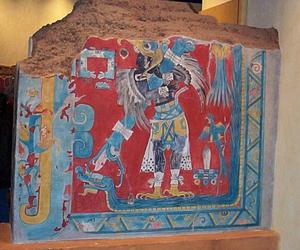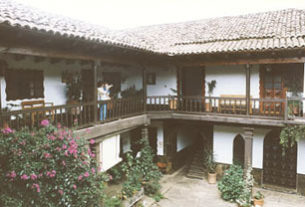Mexican History

Several Mesoamerican researchers have recently cast doubt on the current interpretation of certain features of pre-Columbian cultures and their world outlook — in particular that of the Classical Aztecs and their literature. Revisionist history can represent an attempt to change an historical account for political or personal reasons. Or it can be a response to new evidence or an alternate explanation of historical events.
It is not as simple as that because certain [pseudo] historians reject the academic or “establishment” view of history in order to make money by telling the general public what they want to hear. Academics, on the other hand, are just as prone to fight amongst themselves in order to defend a particular point of view which they may sincerely believe is based on the facts as revealed by solid scientific investigation.
The Nahuatl (Aztec) song-poems are contained in three collections: the Cantares Mexicanos (Mexico City), the Romances de los señores de Nueva España (University of Texas), and a third fragmentary collection in Paris.
In considering the possible pre-Hispanic origin of these Nahuatl poems, several things must be kept in mind. First, the poems in their present form were not written down until after the Spanish Conquest of Mexico in 1521. Prior to the conquest, the oral tradition, which was backed up pictographic codices, prevailed. Secondly, because of the many Christian terms scattered throughout the poems, some scholars think that the poems are late compositions directly influenced by the Spanish missionary-priests. Thirdly, so the argument goes, most of our information about the pre-Conquest Aztecs has filtered down to us mainly through Spanish sources and therefore our information is suspect.
The Nahuatl poems are a good test case because they appear to reflect more of the authentic pre-Hispanic native tradition relatively uninfluenced by the dominant Spanish culture. Sahagún’s Florentine Codex was compiled with the direct help of native informants, but the work was conceived and executed under the direction of the Franciscan himself.
Sahagún’s work provides one of the most accurate accounts of Aztec culture and religion. Nevertheless, the Spanish missionary-priests were fanatically committed to destroying every last vestige of native religion. It is not surprising, therefore, that a certain amount of distortion has crept into our historical records of pre-Columbian civilizations in the Americas. The question is how much of the original native tradition can still be rescued from the rubble of the Spanish invasion.
Oral tradition versus written literature
In an Internet article entitled “Crucible of Distortion” (Copyright 1998), B. Gardner emphasized the fluidity of oral tradition in contrast to a fixed text tradition, and pointed out some of the factors that possibly lead to distortion in our picture of pre-Columbian civilizations. Because the evidence for pre-Hispanicoral tradition has reached us in written form, Gardner argues, our information is very limited. He likens our information to a snapshot that freezes a moment in time, but does not give us the full living ongoing course of events: “Oral tradition is a never-ending movie, and a text is no better than a snapshot of a part of that movie at any one time.”
Like most broad generalizations, this interpretation can be misleading, for not all oral traditions are alike. Some are much more accurate than others, whether religious or secular.
In India, the hymns of the Rig Veda were preserved verbatim for generations through a special mnemonic system of memorization. Irish and Scottish bards premeditated, composed, and then memorized their own poems. Gaelic story-tellers in Celtic Scotland performed long Ossianic tales in prose, the accuracy of which was guaranteed by a critical audience which would correct the story-teller if he deviated too much from the traditional storyline. There are many possible parallels to the Nahuatl poems of ancient Mexico.
Moreover, while a movie is indeed made up of many separate snapshots, they are all strung together and played rapidly enough to give the illusion of movement. Likewise, we can gain information for our movie about pre-contact oral traditions in Mesoamerica by gathering together bits and pieces of information and putting them together in some kind of logical sequence. In social science methodology, for example, a theory of social change may be based upon a series of questionnaires showing how people live in the suburbs. By analyzing and coordinating the results of such a survey, it might be possible to obtain sufficient information for a theory of on-going social change.
So, too, for the Nahuatl poems. From other early sources, we can reconstruct the likely circumstances under which such poems might have been performed. Modern ethnological studies can also provide information on how a living oral tradition functions.
Distortion in the written record
Gardner mentions four main causes of distortion in the current historical record of ancient Mexico: distortion by transcription error, distortion by interpretation, distortion by selection, and distortion by accretion. Many of his views reflect those of other researchers who are also dissatisfied with our present picture of pre-Hispanic Mexico. Therefore, we shall first review certain parts of his analysis and then see how it applies to the Nahuatl song-poems.
“Distortion by Transcription Error” occurs, according to Gardner, when, for example, the scribe does hear properly when recording an oral performance and therefore makes a mistake in the written version. Moreover, the scribe cannot describe all the circumstances of the performance. For example, Gardner attributes the variations in the various accounts of Quetzalcoatl not to the [alleged] fluidity of the oral tradition but rather to mistakes in the transcription.
Because of the basic uniformity in the various sources for the account of the Five Suns, Gardner concludes that the variations must be the result of transcription error. However, a culture or oral tradition that does not adapt to meet new situations quickly becomes a museum piece instead of a living tradition. Of course a tradition must retain certain recognizable features or it becomes something else. Nevertheless, a tradition may take different forms in different situations.
For example, Huichols in one pueblo may say that the Huichols in another pueblo are not performing the Peyote Dance correctly and that only they have the correct interpretation. But the Peyote ceremony itself remains an integral part of the traditional peyote religion. The variations in the dance steps or the words of the peyote songs are simply different interpretations of the same tradition.
There is no doubt that distortion has taken place in the Nahuatl poems because of transcription error. For example, the original manuscript of the Romances de los señores de Nueva España is a paleographers’s nightmare with words crossed out, different spellings of the same word within a few lines, cryptic short forms and various symbols used by the copyist, along with numerous other errors. Sometimes the division of words in the manuscript requires rearranging, as in the printed editions of Garibay and Leon-Portilla. This is what one might expect from a text taken down from an oral recitation.
The problem here is very similar to the Homeric Questions: if the Iliad and Odyssey were oral compositions to start with, how were they first recorded in writing? We may never arrive at a final answer but, through comparative analysis and analogy, we can at least arrive at a plausible explanation.
Gardner stresses that, with the notable exception of Sahagun, most of our descriptions of native oral tradition come to us filtered through the Spanish collectors. As an example of “Distortion by Interpretation,” he refers to a description in Mendieta’s Historia Eclesiastica Indiana in which several friars examined a painting kept by the vicar of a convent showing a picture of “Our Lady” with a cross in her hair. The friars interpreted the cross as a sign that she was most holy, that she would bear a great prophet by a virgin birth, etc. According to Mendieta, it was a reproduction of “some very ancient paintings.” However, there is no indication of the form or the age of these alleged “ancient paintings.”
From the description of the woman in the painting it appears to have been a late work by an Indian under Spanish patronage. If this was the case, then the interpretation given by the fathers was absolutely correct: it was a painting intended to represent the Virgin Mary. Gardner’s point seems to be that the actual painting was native but that the interpretation given by the friars was simply an interpolation of Christian dogma onto a native production. However, we have many such native colonial manuscripts clearly composed in the native style but produced under the influence of the Spanish missionaries. Therefore, this is not a case of “distortion by interpretation” but rather “syncretism” (an attempted union or reconciliation of diverse or opposite tenets or practices).
Examples of possible distortion by interpretation however are found in many of the Aztec song-poems. For example, in Folio 1 of the Romances, the manuscript text reads “…ye temoya y espiritu santo y dios ayeo ayya ohuaya xoxopan in ompa temoya ipalnemoani.” A rough translation might be: “The Holy Spirit and God descend, Ipalnemoani descends from there, from the Green Place.”
- I have followed the more standardized spelling to avoid transcription problems with the original text.
- the meaningless syllables “ayeo ahuaya ayyya ohuaya” represent a kind of musical refrain and cannot be translated.
- Ipalnemoani (literally “he through whom everything lives,” a title of Ometeotl, “God of Duality” (See Leon-Portilla Filosofia Nahuatl, p.382).
The problems of translation and interpretation begin almost immediately. Garibay alters the above manuscript text to read: “…ye temohua ipiltzin … xoxopan in ompa temoya in ipalnemoani.” First, he omits the Christian terms “espiritu santo y dios” and substitutes instead the word “ipiltzin” (the son) thus, getting rid of the more offending Christian phrases and giving the passage a more pre-Hispanic flavor. Then he translates the passage thus: “Ha bajado ya el hijo suyo! En primavera baja alli aquel por quien todo vive!” (Your son has now come down, in spring he through whom everything lives comes down from there). This suggests a pre-Hispanic origin of the Nahuatl poems.
J. Bierhorst, one of the more prolific modern translators of Nahuatl, begins with several unproved assumptions: first, he believes that the Nahuatl poems are “Ghost Dance Songs” intended to summon dead Aztec warriors from heaven to aid the native survivors of the Conquest; secondly that all the songs were put together in their present form in the mid-1500s. He thus effectively eliminates the possibility that some of them at least might be pre-Hispanic compositions, although he grudgingly admits that they might have borrowed heavily from a pre-Conquest repertory. Bierhorst’s English translations reflect his own personal bias: “…the Holy Spirit, God, descends. From Green Places he descends. It’s Life Giver.” In this translation Bierhorst retains the Christian reference but changes it slightly, for the original text reads “…espiritu santo y dios…” (The Holy Spirit and God descend). Moreover, the typical Nahuatl compound word-sentence “ipalnemohuani” is replaced by the term “Life Giver,” thus bringing it more in line with Bierhorst’s Christian or post-Conquest interpretation of the text.
What are we to make of all this? First, let me here are Bierhorst’s conclusions:
- These different types of distortions hinder us from reconstructing the “pre-contact culture” of Central Mexico because we are forced to work mainly with fixed texts that do not give us an adequate picture of the underlying oral tradition.
- Not even texts in Nahuatl can be taken at face value because they were produced under the influences of the Spaniards.
- The Aztec song-poems are not a total fabrication, but they represent a process in which the interests of the conquerors changed the “legendary material” they were collecting from the natives. We can make reasonable reconstructions of pre-contact lore but we must take into account the various types of distortion that have crept into the texts.
I have no quarrel with the admonition that we must take into account all available evidence in attempting to reconstruct pre-Hispanic Aztec history. However, there are a number of unproven assumptions here which we do not have time to deal with in this article.
Suffice it to say that by the time these ancient Aztec song-poems find their way into English translations, the versions diverge so much one from another that the original Aztec composers would be at a loss to know whose work was being translated. The English reader of these exotic texts with no knowledge of Nahuatl or even Spanish is completely at the mercy of the translator who may have his or her own personal agenda, or perhaps an axe to grind.
Much more work remains to be done.


